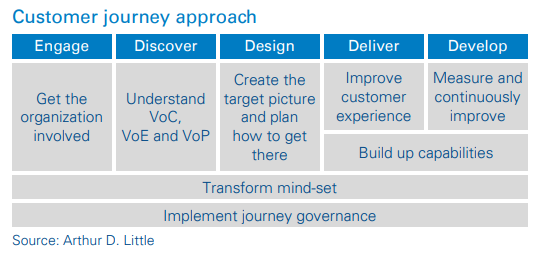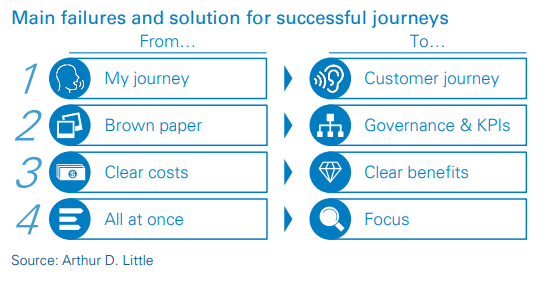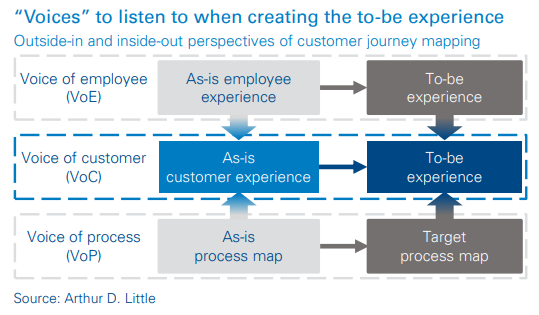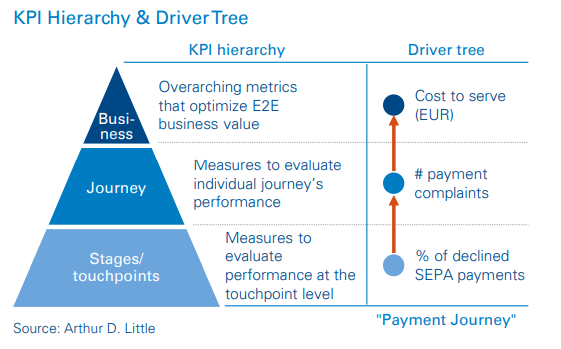
DOWNLOAD
DATE
Contact
Customer journeys are a way for energy companies to record every interaction with their customers, getting an end-toend view of the journeys and processes the customer goes through. It allows them to see processes from the customer perspective, which is a powerful tool to steer the customer experience. However, according to a recent study, more than 93 percent of companies fail to implement customer journeys successfully. In particular, utilities, for which the idea of a customer is comparatively new, frequently fail to implement customer journeys. In this Viewpoint, we make the case for stronger customer involvement, clearer governance, quantification of value, and focus, as we find these to be the four main reasons for failure. Customer journey insight allows businesses to increase customer satisfaction and loyalty, retain customers, and increase sales.
“We serve customers, don’t we?”
It was only a decade ago when utilities didn’t have to think in terms of customers. They worked in natural monopolies, serving points of consumption. In this realm, it was most important to ensure correct and timely billing, as well as speedy collection of outstanding payments. Prevailing IT systems were structured by meter numbers and contained little or no information on the actual customer. However, following market liberalization, the number of players in power and gas retail markets grew.
More pressure was put on utilities through competition, and they began to recognize the human beings behind the points of consumption, who liked to be more than numbers. At the same time, a customer’s energy supplier was a faceless organization that was easily interchangeable. Moreover, companies in other industries, such as Apple and Starbucks, seemed to attribute large amounts of their success to the ability to understand their customers and develop products and services for which those customers were willing to pay a premium – to the point of camping out in front of a store for multiple nights to be the first to receive a new iteration of a product. Inspired by this, utilities such as Endesa, E.ON, RWE/Innogy and local energy providers started large-scale programs to also make themselves more customer centric.
Customer journeys are a common methodology used to foster customer centricity. As illustrated in the below figure, the customer journey method follows a clear approach that comprises five steps, complemented by a continuous mind-set transformation and establishment of journey governance. This approach is exemplary and might see adaptations between different companies.
Five-step journey approach

Once the approach was set, utilities, from retail companies to grid operators and regional providers, hired design companies and staffed their own customer experience teams to kick-start implementation. They developed customer journeys using journey-mapping methodologies. They brought together people from different departments in large workshops to map journeys end to end, which often revealed main points of breakdown for the first time. Top management got involved, and hailed the need to focus on the customer. They sat in focus groups and proclaimed new key performance indicators (KPIs) and governance systems to accommodate journeys within the existing structures.
You probably remember the first time you were invited to a customer journey workshop, or even initiated one. You would have come into a room fully prepared, with large brown papers serving as a blank canvas or already containing a first sketch of a journey. Next to these, someone would have constructed personas of your customers. Hundreds of colorful sticky-notes and markers would have lain ready to be used. You would have been introduced to various colleagues from different departments, whom you had never met, but who were all, in one way or the other, involved in this particular journey.
The workshop would have lasted hours, or even days. Discussions would have been fruitful and inspiring, and revealed many issues and points at which the experience could be improved. By the time the different groups presented their summaries, the boards would have been covered in dozens of sticky-notes, a marker line would have shown the emotional curve of the customer along the journey, and artifacts, such as customer letters, social media posts and advertisements, would have been collected and matched to each of the touchpoints.
Everyone would have left the room motivated and empowered, looking forward to implementing the ideas discussed.
The bubble bursts
However, often nothing happens after such an initiative. And even if something is changed in the workflow, suddenly the legacy IT system doesn’t allow for any changes. This is when the organization first realizes that there is more to customer journeys than colorful sticky-notes and creative workshops. It is hard work to get the improvement measures implemented. This first glimpse of frustration frequently leads to less motivation and an approach that is not followed through.
Until now, most companies, and especially utilities, have failed to properly implement customer journeys. Researchers state that 93 percent of customer experience initiatives are failing. We have identified four main reasons for this.
below summarizes the reasons for failure and approaches to getting it right, which we will outline below.

1. From my journey to the customer journey
The basis for taking a customer journey approach is to understand who your customers are, and which behaviors and expectations they have.
Not your customer
A common trap within customer journey design is when the journey is set up for a customer who is not yours. Utilities tend to have the wrong picture of their actual customer groups because they lack customer information in their systems and inward focus on their organizations. Therefore, the journey is designed for an “ideal” customer instead of the real customer.
Thinking like your customers
The second trap you might have fallen into is subjectivity. Many have taken the right steps to develop journey maps in interdisciplinary workshops, involving people from all parts of the journey. However, customers are often still not directly involved, and therefore the real customer view is missing. These internal journey workshops are prone to drawing on anecdotal evidence rather than real facts about the customer. Confirmation biases and “groupthink” ensue. The resulting subjectively perfect journey often does not reflect the reality of the main customer group. It does not identify the real pain points and misses out the right improvement measures.
Get it right – A 360-degree view of the customer journey
To protect yourself from this trap, you need to get a 360-degree view of the customer journey. This means involving customers directly, through focus groups, home interviews and codesign workshops. This qualitative input needs to be paired with quantitative analyses of received issues, complaints and suggestions, as well as customer quotes. After designing it, you should validate the journey again with customers to ensure it really mirrors their views. Besides the customer view, you should not forget to map out the process journey and the employee journey. Only if you include the voice of the customer (VoC), the voice of the employee (VoE) and the voice of the process (VoP), do you get a holistic picture that allows you to find the best leverage points to improve the experience. For all three of these “voices”, it is important to map the as-is and to-be pictures, as illustrated below.

2. From brown paper to clear governance and KPIs
The main reason for nothing being implemented after the first wave of adoption was lack of empowerment for middle managers to push customer journeys across the functional silos of their organizations. In addition, customer experience would take a backseat as long as incentives and KPIs at this level were not updated.
Get it right – Customer journey governance and KPIs
For customer journeys to be implemented properly, companies need to establish clear governance systems with defined roles and KPIs
Good practice is dissolution of traditional hierarchy and shifting towards a governance system centred around journeys. This governance system includes different roles and responsibilities.
The main role is the journey manager. He or she is responsible for the overall journey work for one particular journey. The journey manager should be a team leader managing a team of stage- and touchpoint managers, as well as the journey value manager.
The stage manager is responsible for one or several stages/ processes within a journey and oversees a team of touchpoint managers, who are in charge of improving the customer experience at one or several touchpoints within the journey.
The journey value manager is an analyst who tracks the journey based on predefined KPIs. Additionally, he or she always revises the journey and continues steady improvement of the customer experience together with the whole journey team.
To make sure the journey has enough attention within the organization, and for escalation reasons, a sponsor – ideally a member of the management team – should act as a sparring partner. The team should work closely together, defining a target picture with an overarching backlog, but then operate with sprint ogic in short iterations to quickly pick up speed and showcase results.
At the same time, changing the customer experience needs to be rewarded. KPIs such as the Net Promoter Score (NPS), need to be included in management’s scorecards and dashboards as part of their decision-making. Figure 4 below shows the different KPI levels throughout the journey. At each of these levels, there needs to be a breakdown to the main value drivers of each touchpoint. KPIs need to be defined and tracked accordingly.
The driver tree example in the below figure shows a typical KPI relationship for a “payment journey”, in which issues with the SEPA payments are a main driver for the overall cost to serve.

3. From costs to quantified benefits
Another major reason for the failure of customer journey programs is lack of quantification of financial benefits from an improved customer experience. Being able to only show clear costs, with an unclear upside, makes it hard for journey managers and sponsors to defend their efforts.
Get it right – Build your case
To pull this lever, companies need to analyze existing customer cohorts, look ahead using analytics, and build momentum around quick wins.
As a start, companies can use historical data about existing customers to construct financial indicators for soft customer KPIs. These values can then be put into business-case calculations, which will showcase the monetary benefit of an increase in customer satisfaction by improving the service level on a journey.
Secondly, utilities should further invest in data analytics to be able to better divide the main drivers of financial benefits. Identifying the strongest relationships between KPIs further helps to refine KPI pyramids and dashboards for decisionmaking.
Thirdly, there are quick wins. Most journey work reveals simple customer issues that can be solved with minimal efforts at high financial benefit to the company.
4. From doing all at once to clear focus
In the 1990s, customer journey mapping was straightforward. There was only an offline world. Now, given the extended time customers spend on their devices, the amount of customer journeys and their complexity increase tremendously.
Often, utilities try to solve the whole web of journeys in one go. Instead, they should apply the “agile” mind-set, which they have already taken on as part of their digital transformation projects, to journeys.
Get it right – Focus, focus, focus
The key is not to over-engineer customer journeys and get lost in the detail. It is important to take a hands-on approach, designing a first set of customer journeys with different entry points, but with clear focus on the journeys which most customers go through. Afterwards, it is important to identify the most critical touchpoints and pain points along a journey. Having identified these, think about measures to take to improve those pain points, and prioritize them. Prioritization should consider constraints, customer value, company value, measurable impact and ease of implementation. Breaking these prioritized measures down into simple tasks is the first step. These tasks should feed a backlog, which should then be worked off in an iterative fashion.
Summary
Customer journeys are a powerful tool to bring customer centricity to life, and it does not take much to get started. The key is prioritization and the ability to link the improvements to monetary benefits. To integrate customer journeys into daily business, companies need be bolder in moving away from traditional organizational structures or matrix layouts and give journey governance the priority. Clear KPIs, along with incentives for middle management, will anchor the new organization.


